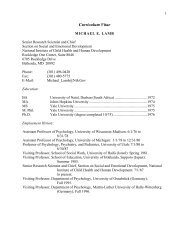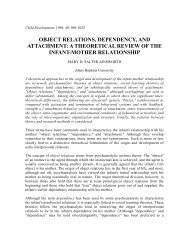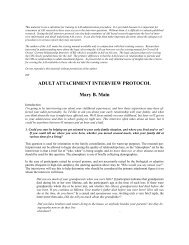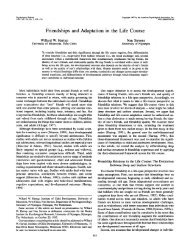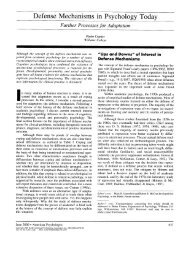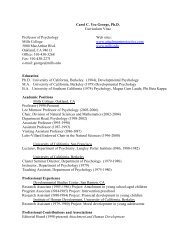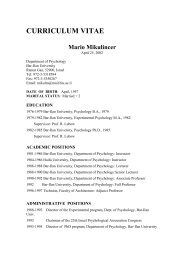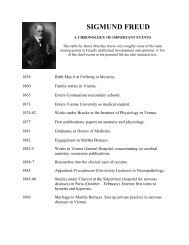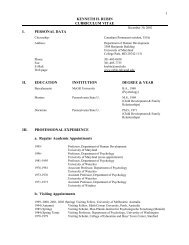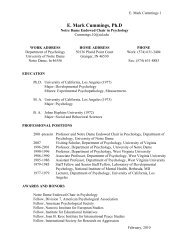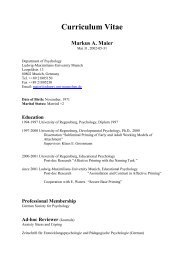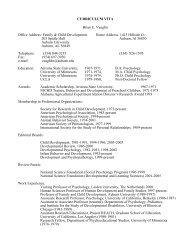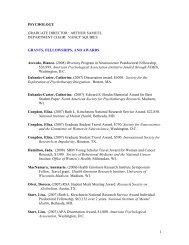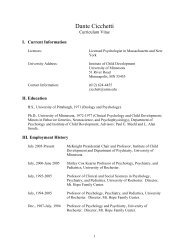the origins of attachment theory: john bowlby and mary ainsworth ...
the origins of attachment theory: john bowlby and mary ainsworth ...
the origins of attachment theory: john bowlby and mary ainsworth ...
You also want an ePaper? Increase the reach of your titles
YUMPU automatically turns print PDFs into web optimized ePapers that Google loves.
So long as we trace <strong>the</strong> development from its final outcome backwards, <strong>the</strong> chain <strong>of</strong> events<br />
appears continuous, <strong>and</strong> we feel we have gained an insight which is completely satisfactory<br />
or even exhaustive. But if we proceed in <strong>the</strong> reverse way, if we start from <strong>the</strong> premises<br />
inferred from <strong>the</strong> analysis <strong>and</strong> try to follow <strong>the</strong>se up to <strong>the</strong> final results, <strong>the</strong>n we no longer<br />
get <strong>the</strong> impression <strong>of</strong> an inevitable sequence <strong>of</strong> events which could not have o<strong>the</strong>rwise been<br />
determined. (p. 167)<br />
In elucidating how each idea <strong>and</strong> methodological advance became a stepping stone for <strong>the</strong><br />
next, my retrospective account <strong>of</strong> <strong>the</strong> <strong>origins</strong> <strong>of</strong> <strong>attachment</strong> <strong>the</strong>ory makes <strong>the</strong> process <strong>of</strong> <strong>the</strong>ory<br />
building seem planful <strong>and</strong> orderly. No doubt this was <strong>the</strong> case to some extent, but it may <strong>of</strong>ten not<br />
have seemed so to <strong>the</strong> protagonists at <strong>the</strong> time.<br />
John Bowlby<br />
ORIGINS<br />
After graduating from <strong>the</strong> University <strong>of</strong> Cambridge in 1928, where he received rigorous<br />
scientific training <strong>and</strong> some instruction in what is now called developmental psychology, Bowlby<br />
performed volunteer work at a school for maladjusted children while reconsidering his career<br />
goals. His experiences with two children at <strong>the</strong> school set his pr<strong>of</strong>essional life on course. One was<br />
a very isolated, remote, affectionless teenager who had been expelled from his previous school for<br />
<strong>the</strong>ft <strong>and</strong> had had no stable mo<strong>the</strong>r figure. The second child was an anxious boy <strong>of</strong> 7 or 8 who<br />
trailed Bowlby around <strong>and</strong> who was known as his shadow (Ainsworth, 1974). Persuaded by this<br />
experience <strong>of</strong> <strong>the</strong> effects <strong>of</strong> early family relationships on personality development, Bowlby<br />
decided to embark on a career as a child psychiatrist (Senn, 1977h).<br />
Concurrently with his studies in medicine <strong>and</strong> psychiatry, Bowlby undertook training at <strong>the</strong><br />
British Psychoanalytic Institute. During this period Melanie Klein was a major influence <strong>the</strong>re (<strong>the</strong><br />
institute had three groups: Group A sided with Freud, Group B sided with Klein, <strong>and</strong> <strong>the</strong> Middle<br />
Group sided with nei<strong>the</strong>r). Bowlby was exposed to Kleinian (Klein, 1932) ideas through his<br />
training analyst, Joan Riviere, a close associate <strong>of</strong> Klein, <strong>and</strong> eventually through supervision by<br />
Melanie Klein herself. Although he acknowledges Riviere <strong>and</strong> Klein for grounding him in <strong>the</strong>



